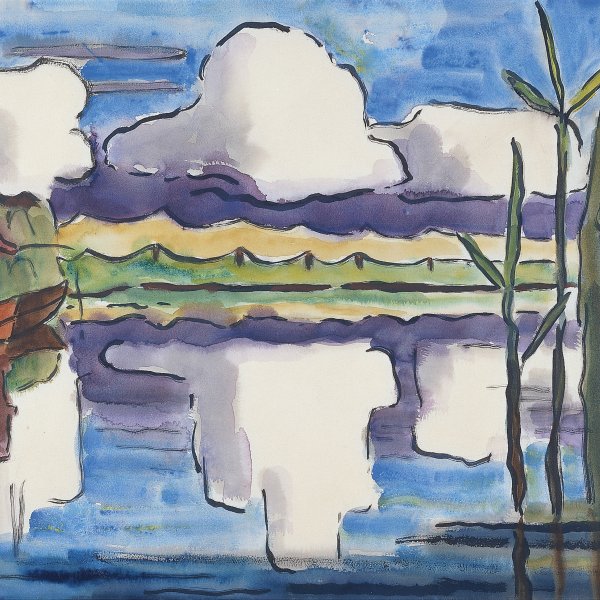Autumn Landscape in Oldenburg
Karl Schmidt-Rottluff painted this Autumn Landscape in Oldenburg during his first summer in the coastal village of Dangast in 1907. From that year onwards he would spend lengthy periods of time there. Accompanied by Erich Heckel, another member of the Die Brücke [The Bridge] Expressionist group, Heckel was anxious to find a rural arcadia far from Dresden where he lived during the remainder of the year.
The landscape in the Oldenburg region on the North Coast surpassed his expectations and encouraged Heckel to work feverishly. The works from this period, with their short, loose brushstrokes of vivid colours, still relate to the admiration that the Die Brücke artists felt for Van Gogh during the group’s early phase. Heckel’s technique, however, differs from Van Gogh’s in that his heavily charged brushstrokes are applied in a far less systematic manner.
MRA
In summer 1907 Karl Schmidt-Rottluff travelled to the village of Dangast in the Oldenburg region, on the North Sea coast. No sooner had he arrived than he hastily wrote to his friend Erich Heckel to encourage him to follow in his footsteps, stating that “the region was quite fantastic, everything simply demanding to be painted.” Both artists kept coming back to this place for several years and painted their most memorable plein air landscapes of the Expressionist period there. As a rule the Die Brücke artists left Dresden every summer, heading for remote places or the nearby Moritzburg lakes. From 1903 onwards, Nolde spent his summers in Alsen, a Baltic village where he was visited by Schmidt-Rottluff in 1906. Kirchner found his paradise in the isle of Fehmarn, also located in the Baltic Sea, between Germany and Denmark, while Pechstein would travel to the faraway Nidden.
Karl Schmidt-Rottluff travelled to Dangast every summer from 1907 to 1912 and Heckel paid him a visit every year until 1910, when he was accompanied by Pechstein. As Peter Vergo has pointed out, rather than seeking secluded spots in pursuit of “new and exciting themes to paint, ” what these young artists aimed for was to emulate Gauguin’s gesture of turning his back on civilisation and the trappings of bourgeois values.
Autumn Landscape in Oldenburg, painted in 1907 during Schmidt-Rottluff ’s first stay in Dangast, is very close in style to the Brickworks by Heckel, his travelling companion, also in the Museo Thyssen-Bornemisza collection. Both works exhibit the same influence of the painting of Van Gogh and attest to the homogenous style that characterised the early years of the Die Brücke group. The dense technique of loose, agitated brushstrokes and the direct application of hardly-mixed, vivid colours creating very marked contrasts recall the landscapes of the Dutch painter. In the case of Schmidt-Rottluff, it is also necessary to add the influence of French plein air painting, evident in the painter’s interest in capturing the light effects of the changing atmosphere. The very title of the work, which alludes to a specific season of the year, confirms this influence.
The present landscape, which represents a small rural property, demonstrates very clearly how Schmidt-Rottluff constructs the space through colour. The use of a restricted palette of a few basic colours — green, yellow, red and blue — gives the composition an intense emotional impact and underlines the painter’s skills as a fine colourist. In a letter sent to Peter Selz in 1952, Erich Heckel recognized that “It is difficult to decide what each of us gave to the other in terms of stimulus, because it was all very reciprocal and often shared... but what is clear is that Schmidt-Rottluff contributed the glowing and pure colour of Chemnitz.”
Paloma Alarcó









